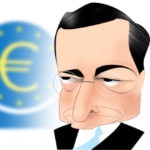The ECB: What should we expect from Draghi in the second half of his tenure?
Lower interest rates on deposits, extension of the quantitative easing policy until March 2017... the measures announced in the ECB’s last meeting did not seem enough. This Thursday, ECB President Mario Draghi will chair the first meeting of a 2016 riddled with challenges, with the confidence of someone who has succeeded in dizzying situations and prevented the collapse of the single currency. His pledge in 2012 to "do whatever it takes to preserve the euro. And believe me, it will be enough" still resounds in the collective mind of the EU. We will review now some of his most relevant decisions, and what’s yet to come.

A priori, it doesn’t look like the measures announced by the ECB fell short. Mario Draghi, now entering the second half of its mandate, has acted firmly during the most critical instances of his first four years at the helm of the ECB. He took over the ECB barely hours after Greek prime minister Yorgos Papandreu called a referendum on the European reform program. In a matter of months, Draghi inaugurated his term buying Spanish and Italian debt in the secondary markets to calm investors in the midst of the Greek earthquake.
"The ECB is ready to do whatever it takes to preserve the euro. And believe me, it will be enough"
Other key measures include lowering interest rates to almost 0%, the three LTRO allotments that injected over €1 trillion in the European financial system, the launching of the OMT program (Outright Monetary Transactions) in July 2012, and which were a tipping point in the development of the sovereign debt crisis, or, more recently, public bond purchases. The institution had to overcome hurdles that not long ago seemed impossible to trespass, like pushing deposit rates into negative territory, as Mario Draghi recognized in an interview with Italian newspaper Il Sole 24 Ore.
He has also played a pivotal role in the promotion of far reaching institutional reform in the Eurozone: The creation of the banking union and the concentration of oversight powers in the ECB. This banking union, the Single Supervisory Mechanism and the stress tests in European banks have brought a paradigm shift in the region’s financial sector.
Although the measures adopted by the ECB seem to have taken effect, at least partially (reducing fragmentation in the Eurozone, cutting interest rates on loans, and dissipating deflation prospects), its main detractors argue that the inflation goal is still far from accomplished and that growth in the Eurozone is fragile and uneven.
The question, therefore, is, can the ECB solve all this? For the time being, and as the ECB constantly reminds, it looks like it will be hard without support from Eurozone governments in the shape of new structural measures.
Chronology of the ECB's decisions in the last four years

What lies ahead for the ECB?
“The ground covered until now provides no basis for self-indulgence, as the challenges that lie ahead are by no ways minor. In the field of monetary policy, the big question that remains is if the ECB will be able to take inflation back to the target bracket within the defined deadline, 2017”, wrote José Manuel González-Páramo, Executive Board Member of BBVA and member of the Executive Board of the European Central Bank between 2004 and 2012, in El Mundo newspaper, last December.
Indeed, experts seem to agree that the ECB’s main concern will be to bring inflation back towards 2% and dissipate the fears of deflation. But, apart from inflation, the ECB will be facing three key challenges in the next four years:
First, to consolidate the functioning of the Single Supervisory Mechanism (SSM). Here, the ECB will have to juggle his new supervisory role and his monetary policy responsibilities without raising concerns about its independence. Secondly, improve the monetary policy tools, including the design of liquidity absorption instruments. Third, contribute technically to political progress, spearheading the construction of a more genuine and stable monetary union.
One of the challenges the institution faces, just as many other central banks, in an environment where interest rates have dropped to 0%, is the management of expectations, points out Sonsoles Castillo, from BBVA Research, in an Op-Ed published in Expansión in December.
On other occasions, some of the ECB’s decisions have been held to legal questioning, such as the OMT program, which was finally green-lighted by the European Carry out of Justice, or the debate regarding whether the bond buying program breaches the Treaty in public sector monetary funding matters. And the intensity of the legal scrutiny is not likely to lower.
In the future, it looks like Mario Draghi will have to keep on relying on the qualities that, according to experts, have accompanied him so far: A sense of anticipation, deep knowledge of the markets, quick decision-making skills and the ability to communicate.